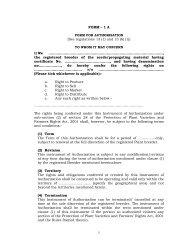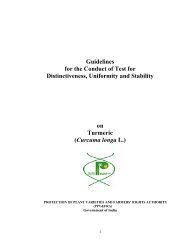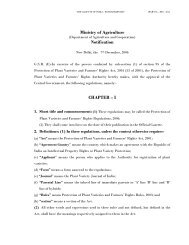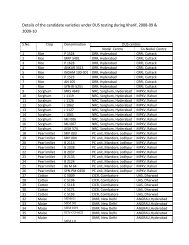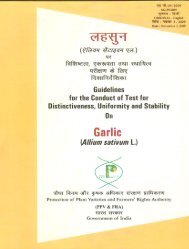Mango - Protection of Plant Varieties & Farmers
Mango - Protection of Plant Varieties & Farmers
Mango - Protection of Plant Varieties & Farmers
You also want an ePaper? Increase the reach of your titles
YUMPU automatically turns print PDFs into web optimized ePapers that Google loves.
I.<br />
fo"k; 1<br />
II.<br />
visf{kr jksi.k lkexzh 1<br />
III.<br />
ijh{k.k djuk 1-2<br />
IV.<br />
f<strong>of</strong>/k;ka vkSj i;Zos{k.k 2<br />
V.<br />
fdLeksa dk lewghdj.k 2-3<br />
VI.<br />
xq.k vkSj fpg~u 3-4<br />
VII.<br />
xq.k&rkfydk 5-10<br />
VIII.<br />
xq.k&rkfydk dh O;k[;k 11-15<br />
IX.<br />
dk;Zcy dk fooj.k 16<br />
X.<br />
Mh;w,l ijh{k.k dsUæ 16<br />
Contents<br />
Page<br />
I. Subject 17<br />
II. <strong>Plant</strong>ing Material Required 17<br />
III. Conduct <strong>of</strong> Tests 17<br />
IV. Methods and Observations 18<br />
V. Grouping <strong>of</strong> <strong>Varieties</strong> 18-19<br />
VI. Characteristics and Symbols 19<br />
VII. Table <strong>of</strong> Characteristics 20-24<br />
VIII. Explanation on the Table <strong>of</strong> Characteristics 25-29<br />
IX. Working Group Details 30<br />
X. DUS testing centres 30<br />
ihihoh ,oa ,Qvkj izkf/kdj.k] Hkkjr ljdkj] ubZ fnYyh<br />
i
ii<br />
ihihoh ,oa ,Qvkj izkf/kdj.k] Hkkjr ljdkj] ubZ fnYyh
1- ikS/kk fdLe vkSj Ñ"kd vf/kdkj laj{k.k vf/kfu;e ¼ihihoh vkSj ,Qvkj vf/kfu;e½ 2001 ds<br />
rgr iathdj.k ds fy, fdLe dk uke j[kus laca/kh ijh{k.k esa vuqiz;ksx ds fy, t#jh ikS/kk<br />
lkexzh dh ek=k vkSj xq.koÙkk fdruh] dgka vkSj dc gksxh bldk fu.kZ; ikS/kk fdLe vkSj Ñ"kd<br />
vf/kdkj laj{k.k izkf/kdj.k ¼ihihoh vkSj ,Qvkj,½ }kjk fd;k tk,xkA vkosnd }kjk Hkkjr ds<br />
vykok fdlh Hkh vU; ns'k dh bl izdkj dh ikS/kk lkexzh dks izLrqr djrs le; ;g lqfuf'pr<br />
fd;k tk,xk fd lacaf/kr ns'k ds dkuwu ,oa f<strong>of</strong>u;eksa ds rgr lhek ‘kqYd vkSj laxjks/k laca/kh<br />
fu/kkZfjr vko';drkvksa dk ikyu fd;k x;k gSA<br />
2- izR;sd LFkku ls 7 dyeksa ds :i esa lkexzh dks vkiwrZ fd;k tkuk gSA<br />
3- jksi.k lkexzh ns[kus esa LoLFk gks] mlesa iq"Vrk dh dksbZ deh u gks] fdlh izdkj ds uk'kdtho<br />
;k jksx ls xzLr u gksA<br />
4- ikS/kk lkexzh dk ,slk dksbZ jklk;fud vFkok tSoHkkSfrd mipkj u fd;k tk,] ftlls fdLe<br />
ds xq.kksa dh vfHkO;fDr izHkkfor gksrh gksA ,slk rHkh fd;k tk, tc l{ke izkf/kdkjh }kjk ,sls<br />
mipkj dh vuqefr nh xbZ gksA ;fn mipkj fd;k x;k gS rks mipkj dk iw.kZ fooj.k fn;k<br />
tkuk pkfg,A<br />
1- Mh;w,l ijh{k.k dh U;wure v<strong>of</strong>/k lkekU;r% f<strong>of</strong>HkUu o"kksZa esa de ls de nks Qyr ekSle gksxhA<br />
;s ijh{k.k de ls de nks LFkkuksa ij fd, tk,axsA<br />
2- ijh{k.k ,slh fLFkfr;ksa esa fd, tkus pkfg, ftuesa fdLe ds lEc) xq.kksa dh vfHkO;fDr rFkk<br />
ijh{k.k iwjk djus ds fy, larks"ktud c
3- ijh{k.k fMtkbu<br />
ijh{k.kksa dh fMtkbu bl izdkj dh gksuh pkfg, fd i;Zos{k.kksa ds izfr fcuk fdlh iwokZxzg ds<br />
uki vFkok x.kuk ds fy, ikS/ks ;k vFkok ikS/ks ds Hkkxksa dks vyx fd;k tk lds vkSj ,slk<br />
c
2- lewghdj.k xq.k os gSa ftuesa] f<strong>of</strong>HkUu LFkkuksa ij mRiUu xq.kksa ds lkFk&lkFk vfHkO;fDr dh<br />
voLFkkvksa dks izysf[kr fd;k x;k gks vkSj ftudk mi;ksx ;k rks O;fDrxr rkSj ij ;k<br />
feys&tqys :i esa vU; ,sls xq.kksa dh vfHkO;fDr ds fy, fd;k x;k gks] tSls lkekU; Kku dh<br />
,slh fdLeksa dk p;u ftUgsa f<strong>of</strong>'k"Vrk dh ijh{kk ds fy, iz;ksx fd, x, Qly mxkus okys<br />
ijh{k.kksa ls i`Fkd j[kk tk lds( vkSj c
4- xq.kksa dh rkfydk ds NBs dkWye esa nh xbZ dksM la[;k ikS/ks dh c
1.<br />
(*)<br />
(+)<br />
uo iÙkh %<br />
,aFkksfl;kfuu jax dh<br />
xgurk ¼uo iÙkh<br />
izLQqVu dh lcls<br />
iqjkuh iÙkh ds iw.kZ<br />
foLrkj ds iwoZ½<br />
vuqifLFkr 1 xqykc [kl<br />
fucZy 3 n'kgjh<br />
e/;e 5 caxuiYyh] yaxM+k<br />
lcy 7 vYQkalks] ckWEcs xzhu<br />
2. i=ny % yackbZ NksVk 3 dyikM~Mh d<br />
e>ksyk 5 rksrkijh<br />
yack 7 jktokyk<br />
3. i=ny % pkSM+kbZ ladjk 3 dyikM~Mh d<br />
e>ksyk 5 yaxM+k<br />
pkSM+k 7 Qtjh<br />
4.<br />
(*)<br />
i=ny % yackbZ@<br />
pkSM++kbZ vuqikr<br />
NksVk 3 ps:e.kh d<br />
e>ksyk 5 Qtjh<br />
cM+k 7 vehu fizal<br />
5. i=ny % vkÑfr vaMkdkj 3 yaxM+k] ckWEcs xzhu d<br />
(+)<br />
nhkZo`Ùkkdkj 5 yky iSjh<br />
izfrvaMkdkj 7 xqykc [kl<br />
6. i=ny % jax gYdk gjk 1 fgelkxj d<br />
e/;e gjk 2 pkSlk<br />
7.<br />
(+)<br />
8.<br />
(+)<br />
xgjk gjk 3 ckWEcs xzhu<br />
i=ny % ,saBu vuqifLFkr 1 lQsnk y[kuÅ d<br />
mifLFkr 9 vYQkalks] pkSlk<br />
i=ny % vk/kkj dh dks.kh; 1 vyqeiqj ckus'kku d<br />
vkÑfr<br />
eqFkjh 2 Qtjh] ckWEcs<br />
xksykdkj 3 fpryk<br />
ihihoh ,oa ,Qvkj izkf/kdj.k] Hkkjr ljdkj] ubZ fnYyh 5
9.<br />
(+)<br />
i=ny % uksd dh<br />
vkÑfr<br />
ruqdkjh 1 iSjh d<br />
yEckxz 2 vkezikyh] n'kgjh<br />
dks.kh; 3 caxuiYyh<br />
10. i.kZo`ar % yackbZ NksVk 1.5 ¼lsa-eh-) 3 ysMkfo;ks d<br />
e>ksyk(1.5-3.0 lsa-eh-) 5 n'kgjh<br />
yack (> 3.0 lsa-eh-) 7 Qtjh<br />
11. iq"iu dk le; vxsrh 3 ,YQkalks [k<br />
e/;e 5 n'kgjh] oujkt<br />
iNsrh 7 uhye<br />
12.<br />
(*)<br />
(+)<br />
13.<br />
(+)<br />
14.<br />
(+)<br />
15.<br />
(*)<br />
16.<br />
(*)<br />
17.<br />
(*)<br />
18.<br />
(*)<br />
(+)<br />
iq"iØe % yackbZ NksVk (< 20 lsa-eh-) 3 yaxM+k [k<br />
e>ksyk (20-30 lsaeh-)<br />
5 tkyhe.kh<br />
yack (> 30 lsa-eh-) 7 ckWEcs xzhu<br />
iq"iØe % O;kl NksVk (< 7.5 lsa-eh-) 3 yaxM+k [k<br />
e>ksyk(7.5-15 lsa-eh-) 5 pkSlk<br />
yack (> 15 lsa-eh-) 7 lsfi;k<br />
iq"iØe % yackbZ@ NksVk 3 I;kjh [k<br />
pkSM+kbZ dk vuqikr e>ksyk 5 Hkwfn;k<br />
cM+k 7 rksrkijh jsM Leky<br />
iq"iØe % v{k vuqifLFkr ;k fucZy 1 fxykl] pkSlk [k<br />
rFkk ‘kk[kkvksa dk e/;e 3 vkezikyh<br />
,aFkksfl;kfuu jax lcy 5 vfEcdk<br />
ifjiDo Qy % yackbZ NksVk (< 5 lsa-eh-) 3 byk;ph] fpYrk [kl x<br />
e>ksyk (5-10 lsa-eh-) 5 xkSjftr] ckWEcs xzhu<br />
yack (< 10 lsa-eh-) 7 rksrkijh<br />
ifjiDo Qy % pkSM+kbZ ldjk 3 ps:e.kh x<br />
e>ksyk 5 n'kgjh<br />
pkSM+k 7 Qtjh] jktokyk<br />
ifjiDo Qy %<br />
yackbZ@pkSM+kbZ dk<br />
vuqikr<br />
NksVk 3 byk;ph x<br />
e>ksyk 5 csuthj<br />
cM+k 7 rksrkijh<br />
6<br />
ihihoh ,oa ,Qvkj izkf/kdj.k] Hkkjr ljdkj] ubZ fnYyh
19.<br />
(*)<br />
(+)<br />
20.<br />
(*)<br />
ifjiDo Qy % vuqizLFk<br />
dkV esa vkÑfr<br />
ifjiDo Qy % fNyds<br />
dk jax<br />
21. ifjiDo Qy %<br />
ysaVhlsYl dk kuRo<br />
22. ifjiDo Qy %<br />
ysaVhlsy rFkk fNyds<br />
ds cht dk<br />
fojks/kkHkklh jax<br />
23. ifjiDo Qy %<br />
ysaVhlsYl dk vkdkj<br />
24. ifjiDo Qy %<br />
ysafVlsy ds dkj.k<br />
lrg dk [kqjnjkiu<br />
¼pVdu½<br />
25.<br />
(+)<br />
26.<br />
(+)<br />
27.<br />
(+)<br />
ifjiDo Qy % MaBy<br />
ij xwgk dh mifLFkfr<br />
ifjiDo Qy % MaBy<br />
ij xwgk dh xgjkbZ<br />
ifjiDo Qy % daB dh<br />
mifLFkfr<br />
e/;e nhkZo`Ùkkdkj 1 - x<br />
pkSM+k nhkZo`Ùkkdkj 2 n'kgjh] vkezikyh<br />
xksykdkj 3 :ekuh<br />
dsoy ihyk 1 caxuiYyh x<br />
dsoy gjk 2 ckEcs xzhu] Qtjh<br />
gjk vkSj ihyk 3 ckWEcs ;syks<br />
gjk vkSj ukjaxh 4 efYydk<br />
gjk vkSj xqykch 5 ckjkeklh vgjk<br />
gjk vkSj yky 6 --------<br />
gjk vkSj cSaxuh 7 vfEcdk<br />
fojy 3 caxuiYyh x<br />
e/;e 5 fd'kuHkksx<br />
lku 7 uhye<br />
fucZy 3 caxuiYyh x<br />
e/;e 5 gfnZy vt+ht+<br />
lcy 7 yaxM+k<br />
NksVk 3 uhye x<br />
e>ksyk 5 yaxM+k<br />
cM+k 7 ckWEcs xzhu<br />
vuqifLFkr 1 vYQkalks x<br />
mifLFkr 9 vdZ uhyfdju<br />
vuqifLFkr 1 n'kgjh x<br />
mifLFkr 9 eksguHkksx<br />
mFkyh 1 - x<br />
e/;e 2 c`ankouh<br />
xgjh 3 eksgu Hkksx<br />
vuqifLFkr 1 n'kgjh x<br />
mifLFkr 9 rksrkijh<br />
ihihoh ,oa ,Qvkj izkf/kdj.k] Hkkjr ljdkj] ubZ fnYyh 7
28. ifjiDo Qy % daB dh<br />
yackbZ<br />
29.<br />
(*)<br />
(+)<br />
30.<br />
(*)<br />
(+)<br />
31.<br />
(+)<br />
32.<br />
(+)<br />
33.<br />
(*)<br />
(+)<br />
34.<br />
(*)<br />
35.<br />
(*)<br />
(+)<br />
36.<br />
(+)<br />
ifjiDo Qy % izfri`"B<br />
Lda/k dh vkÑfr<br />
ifjiDo Qy % i`"B<br />
Lda/k dh vkÑfr<br />
ifjiDo Qy % izfri`"B<br />
Lda/k esa [kkaps dh<br />
mifLFkfr<br />
ifjiDo Qy % izfri`"B<br />
Lda/k ij Qqyko<br />
ifjiDo Qy % dksVj<br />
dh mifLFkfr<br />
ifjiDo Qy % dksVj<br />
dh xgjkbZ<br />
ifjiDo Qy %<br />
<strong>of</strong>rZdkxz xrZ dk<br />
fudVLFk Qqyko<br />
ifjiDo Qy %<br />
<strong>of</strong>rdkxz xrZ ij fpg~u<br />
NksVk 3 uhye x<br />
e>ksyk 5 jkW;y Lis'ky<br />
yack 7 rksrkijh<br />
Åij dh vksj xksy 1 caxuiYyh x<br />
ckgj dh vksj xksy 2 :ekuh<br />
uhps dh vksj xksy 3 vksyksvj<br />
uhps dh vksj ksyk 3 vejft;ks<br />
cM+k 5 yTtr cD'k<br />
8<br />
ihihoh ,oa ,Qvkj izkf/kdj.k] Hkkjr ljdkj] ubZ fnYyh
37. ifjiDo Qy % MaBy NksVk 3 nwf/k;k x<br />
tksM+ dk O;kl e>ksyk 5 ps:e.kh<br />
cM+k 7 rksrkijh<br />
38. ifjiDo Qy % fNyds gjk 1 ckWEcs xzhu k<br />
(*) dk izeq[k jax ihyk gjk 2 Qtjh<br />
gjk vkSj ihyk 3 pkSlk<br />
ihyk 4 xkSjftr<br />
ihyk ukjaxh 5 efYydk<br />
ihyk vkSj ukjaxh 6 lkjnk Hkksx<br />
ukjaxh 7 -<br />
ihyk vkSj yky 8 othj ilan<br />
ukjaxh vkSj yky 9 -<br />
yky 10 -<br />
ukjaxh vkSj cSaxuh 11 -<br />
yky vkSj cSaxuh 12 oujkt<br />
cSaxuh 13 vfEcdk<br />
39. ifjiDo Qy % fNyds vuqifLFkr 1 n'kgjh M-<br />
dh LiSfDyax mifLFkr 9 iwlk lw;Z<br />
40. ifjiDo Qy % fNyds iryk 3 yaxM+k M-<br />
dh eksVkbZ e/;e 5 n'kgjh<br />
41. ifjiDo Qy % fNyds<br />
ls xwns dk fpiduk<br />
42. ifjDo Qy % xwns dk<br />
eq[; jax<br />
eksVk 7 ySeu<br />
fucZy 3 yaxM+k k<br />
e/;e 5 efYydk<br />
lcy 7 rksrkijh<br />
gjkiu fy, ihyk 1 - k<br />
gYdk ihyk 2 rksrkijh<br />
e/;e ihyk 3 :ekuh<br />
gYdk ukjaxh 4 n'kgjh<br />
e/;e ukjaxh 5 fulkj ilan<br />
xgjk ukjaxh 6 vkezikyh<br />
ihihoh ,oa ,Qvkj izkf/kdj.k] Hkkjr ljdkj] ubZ fnYyh 9
43. ifjiDo Qy % xwns<br />
dk dM+kiu<br />
44. ifjiDo Qy %<br />
jlhykiu<br />
45. ifjiDo Qy % xwns dh<br />
cukoV<br />
46.<br />
(*)<br />
ifjiDo Qy % xqByh<br />
ls fpids js'ks dh ek=k<br />
47. ifjiDo Qy % fNyds<br />
ls fpids js'ks dh ek=k<br />
48. xqByh % lrg ls<br />
vyxko<br />
49. (+) cht % xqByh dk ik'oZ<br />
n`';<br />
ueZ 3 [kkl&my&[kkl k<br />
e/;e 5 n'kgjh<br />
dM+k 7 efYydk] rksrkijh<br />
de 3 rksrkijh k<br />
e/;e 5 n'kgjh<br />
vf/kd 7 lQsnk y[kuÅ<br />
eghu 3 xkSjftr k<br />
e/;e 5 n'kgjh] vkezikyh<br />
eksVk 7 Qtjh<br />
de 3 n'kgjh k<br />
e/;e 5 lQsnk efygkckn<br />
vf/kd 7 lQsnk y[kuÅ<br />
de 3 lyse caxyksjk k<br />
e/;e 5 pkSlk<br />
vf/kd 7 Qtjh<br />
[kkapsnkj 1 pkSlk k<br />
fpduk 2 jsVkWy<br />
/kkjhnkj 3 lyse caxyksjk<br />
izfrvaMkdkj 1 fulkj ilan] n'kgjh k<br />
lse tSlk vkdkj 2 lQsnk y[kuÅ<br />
50. (*) cht % Hkzw.ktrk ,dHkzw.kh; 1 n'kgjh] yaxM+k] pkSlk k<br />
cgq&Hkzw.kh; 9 dq:Ddu] panzdj.k]<br />
ewoanu<br />
51. (*) Qy ifjiDork dk<br />
le;<br />
vfr vxsrh 1 xkSjftr k<br />
vxsrh 3 ckEcs xzhu<br />
e/;e 5 n'kgjh<br />
iNsrh 7 vkezikyh] efYydk<br />
vfr iNsrh 9 uhye<br />
10<br />
ihihoh ,oa ,Qvkj izkf/kdj.k] Hkkjr ljdkj] ubZ fnYyh
ihihoh ,oa ,Qvkj izkf/kdj.k] Hkkjr ljdkj] ubZ fnYyh 11
12<br />
ihihoh ,oa ,Qvkj izkf/kdj.k] Hkkjr ljdkj] ubZ fnYyh
ihihoh ,oa ,Qvkj izkf/kdj.k] Hkkjr ljdkj] ubZ fnYyh 13
14<br />
ihihoh ,oa ,Qvkj izkf/kdj.k] Hkkjr ljdkj] ubZ fnYyh
ihihoh ,oa ,Qvkj izkf/kdj.k] Hkkjr ljdkj] ubZ fnYyh 15
IX.<br />
dk;Z ny dk fooj.k<br />
;s ijh{k.k fn'kkfunsZ'k ikS/kk fdLe vkSj Ñ"kd vf/kdkj laj{k.k izkf/kdj.k }kjk dk;Zcy<br />
¼4@2006½ ds }kjk fodflr fd, x, gSaA<br />
dk;Z cy ¼4@2006½ ds lnL; %<br />
MkW- dhfrZ flag<br />
MkW- ,u-Mh- tEHkkys<br />
MkW- ch-,e-lh- jsM~Mh<br />
MkW- ,l-ds- jkW;<br />
MkW- 'kSysUæ jktu<br />
MkW- ,-ds- flag<br />
& v/;{k] dk;Zcy<br />
& lnL;] dk;Zcy<br />
& lnL;] dk;Zcy<br />
& lnL;] dk;Zcy<br />
& lnL;] dk;Zcy<br />
& lnL;&lfpo] dk;Zcy<br />
uksMy O;fDr<br />
MkW- 'kSysUæ jktu] iz/kku oSKkfud<br />
dsUæh; miks".k ckxokuh laLFkku] iks-vk- dkdsjh] jsgeku[ksM+k] y[kuÅ ¼mÙkj izns'k½<br />
lg&uksMy O;fDr<br />
MkW- ,e-vkj- fnus'k] iz/kku oSKkfud<br />
QyoxhZ; Qlysa laHkkx] Hkkjrh; ckxokuh vuqla/kku laLFkku] caxyw: ¼dukZVd½<br />
MkW- ch-vkj- lkYoh] izHkkjh vf[ky Hkkjrh; lefUor vuqla/kku ifj;kstuk<br />
{ks=h; Qy vuqla/kku dsUæ ¼Mhch,ldsdsoh½] osacqykZ&416516] ftyk fla/kqnqxZ ¼egkjk"Vª½<br />
X. Mh;w,l ijh{k.k dsUnz<br />
uksMy Mh;w,l ijh{k.k dsUnz<br />
dsUnzh; miks".k dfVca/kh; ckxokuh laLFkku] iksvk-<br />
dkdksjh] jsgeku[ksM+k] y[kuÅ ¼m-iz-½<br />
vU; Mh;w,l ijh{k.k dsUnz<br />
QyoxhZ; Qlysa laHkkx] Hkkjrh; ckxokuh<br />
vuqla/kku laLFkku] cSaxyq#<br />
{ks=h; Qy vuqla/kku dsUnz] osuxqysZ&416516] ftyk]<br />
fla/kqMxZ ¼egkjk"Vª½<br />
16<br />
ihihoh ,oa ,Qvkj izkf/kdj.k] Hkkjr ljdkj] ubZ fnYyh
<strong>Mango</strong> (Mangifera indica L.)<br />
I. Subject<br />
These test guidelines shall apply to all varieties <strong>of</strong> <strong>Mango</strong> (Mangifera indica L.)<br />
II.<br />
Material required<br />
1. The <strong>Protection</strong> <strong>of</strong> <strong>Plant</strong> <strong>Varieties</strong> and <strong>Farmers</strong>’ Rights Authority (PPV & FRA) shall decide<br />
on the quantity and quality <strong>of</strong> the plant material required for testing the variety and when<br />
and where it is to be delivered for registration under the <strong>Protection</strong> <strong>of</strong> <strong>Plant</strong> <strong>Varieties</strong> and<br />
<strong>Farmers</strong>’ Rights (PPV & FRA) Act, 2001. Applicants submitting such plant material from<br />
a country other than India shall make sure that all customs and quarantine requirements<br />
stipulated under relevant national legislations and regulations are complied with.<br />
2. The material is to be supplied in the form 7 grafts for each location.<br />
3. The plant material supplied should be visibly healthy, not lacking in vigour, nor affected by<br />
any important pest or disease.<br />
4. The plant material should not have undergone any treatment, which would affect the<br />
expression <strong>of</strong> the characteristics <strong>of</strong> the variety, unless the competent authorities allow<br />
or request such treatment. If it has been treated, full details <strong>of</strong> the treatment must be given.<br />
III. Conduct <strong>of</strong> tests<br />
1. The minimum duration <strong>of</strong> the DUS tests shall normally be at least two fruiting season in<br />
different years. Tests shall be conducted at least at two places.<br />
2. The tests should be carried out under conditions ensuring satisfactory growth for the<br />
expression <strong>of</strong> the relevant characteristics <strong>of</strong> the variety and for the conduct <strong>of</strong><br />
the examination. In particular, it is essential that the trees produce a satisfactory crop <strong>of</strong><br />
fruit in each <strong>of</strong> the two growing cycles.<br />
3. Test design<br />
The design <strong>of</strong> the tests should be such that plants or parts <strong>of</strong> plants may be removed for<br />
measurement or counting without prejudice to the observations which must be made up to<br />
the end <strong>of</strong> the growing cycle.<br />
PPV & FR Authority. GOI. New Delhi 17
IV. Methods and observations<br />
The characteristics described in the Table <strong>of</strong> characteristics (see section VII) shall be used<br />
for the testing varieties and hybrid for their DUS.<br />
1. For the assessment <strong>of</strong> Distinctiveness and Stability observation shall be made on 5 plants or<br />
parts taken from each <strong>of</strong> 5 plants. In the case <strong>of</strong> parts <strong>of</strong> plants, the number to be taken from<br />
each <strong>of</strong> the plants should be 2.<br />
2. Mature leaves in the middle third <strong>of</strong> the youngest shoots not showing signs <strong>of</strong> active growth<br />
should be selected for the observations on the leaf.<br />
3. Observations on the inflorescences should be made at the time <strong>of</strong> full flowering on terminal<br />
panicles <strong>of</strong> typical shoots from the exposed regions <strong>of</strong> the tree.<br />
4. Observations on the mature fruit should be recorded when fruit is ready for harvesting. At<br />
this stage flesh is still quite firm and has not become juicy but has started colouring around<br />
the stone.<br />
5. The ripe fruit is the fruit at the stage ready for consumption. This stage is reached when the<br />
flesh is juicy and has become coloured from the stone to the skin.<br />
V. Grouping <strong>of</strong> varieties<br />
1. The candidate varieties for DUS testing shall be divided into groups to facilitate the assessment<br />
<strong>of</strong> Distinctiveness. Characteristics, which are known from experience not to vary, or to vary<br />
only slightly within a variety and which in their various states are fairly evenly distributed<br />
across all varieties in the collection are suitable for grouping purpose.<br />
2. Grouping characteristics are those in which the documented states <strong>of</strong> expression, even where<br />
produced at different locations, can be used, either individually or in combination with other<br />
such characteristics: (a) to select varieties <strong>of</strong> common knowledge that can be excluded from<br />
the growing trial used for examination <strong>of</strong> distinctiveness; and (b) to organize the growing<br />
trial so that similar varieties are grouped together.<br />
The following characteristics are to be used for grouping mango varieties:<br />
a. Mature fruit: ratio <strong>of</strong> length/width (Characteristic 1)<br />
b. Mature fruit: shape <strong>of</strong> ventral shoulder (Characteristic 29)<br />
c. Mature fruit: Presence <strong>of</strong> sinus (Characteristic 33)<br />
18<br />
PPV & FR Authority. GOI. New Delhi
d. Seed: Embryony (Characteristic 50)<br />
e. Time <strong>of</strong> fruit maturity (Characteristic 51)<br />
VI. Characteristics and symbols<br />
1. To assess Distinctiveness, Uniformity and Stability, the characteristics and their states as<br />
given in the Table <strong>of</strong> characteristics (Section VII) shall be used.<br />
2. Notes (1 to 9) shall be given for each state <strong>of</strong> expression for different characteristics for the<br />
purpose <strong>of</strong> electronic data processing.<br />
3. Legend<br />
(*) Characteristics that shall be observed during every growing season on all varieties and shall<br />
always be included in the description <strong>of</strong> the variety, except when the state <strong>of</strong> expression <strong>of</strong><br />
any <strong>of</strong> these characters is rendered impossible by a preceding phenological characteristic<br />
or by the environmental conditions <strong>of</strong> the testing region. Under such exceptional situation,<br />
adequate explanation shall be provided.<br />
(+) See Explanation on the Table <strong>of</strong> characteristics in Section VIII. It is to be noted that for<br />
certain characteristics. The plant parts on which observations to be taken are given in the<br />
explanation or figure(s) for clarity and not the colour variation.<br />
4. A code number in the sixth column <strong>of</strong> Table <strong>of</strong> characteristics indicates the optimum stage<br />
for the observation <strong>of</strong> each characteristic during the growth and development <strong>of</strong> plant. The<br />
relevant growth stages corresponding to these code numbers are described below:<br />
a) Observations on the leaf which should be made on mature leaves in the middle third <strong>of</strong><br />
the youngest shoots not showing signs <strong>of</strong> active growth.<br />
b) Inflorescences should be selected from terminal panicles <strong>of</strong> typical shoots from<br />
the exposed regions <strong>of</strong> the tree. Observations should be made at the time <strong>of</strong> full<br />
flowering.<br />
c) The mature fruit is the fruit at the stage ready for harvesting. This stage is reached<br />
when the flesh is still quite firm and has not become juicy but has started colouring<br />
around the stone.<br />
d) The ripe fruit is the fruit at the stage ready for consumption. This stage is reached when<br />
the flesh is juicy and has become coloured from the stone to the skin.<br />
e) Observations on the lenticels and the speckling <strong>of</strong> the skin should be made on the<br />
lateral side <strong>of</strong> the fruit.<br />
PPV & FR Authority. GOI. New Delhi 19
VII. Table <strong>of</strong> characteristics<br />
S. No. Characteristics States Notes Example<br />
variety<br />
Stage <strong>of</strong><br />
Observation<br />
1 2 3 4 5 6<br />
1. Young leaf: Absent 1 Gulab Khas<br />
(*) intensity <strong>of</strong><br />
Weak 3 Dashehari<br />
(+) a n t h o c y a n i n<br />
colouration (before Medium 5 Banganapalli, Langra<br />
full expansion <strong>of</strong><br />
Strong<br />
oldest leaf <strong>of</strong> the<br />
7 Alphonso, Bombay Green<br />
new flush)<br />
2. Leaf blade: length Short 3 Kalapaddy a<br />
Medium 5 Totapuri<br />
Long 7 Rajawala<br />
3. Leaf blade: width Narrow 3 Kalapaddy a<br />
Medium 5 Langra<br />
Broad 7 Fajri<br />
4.<br />
(*)<br />
5.<br />
(+)<br />
Leaf blade: ratio<br />
length/width<br />
Small 3 Cherumani a<br />
Medium 5 Fajri<br />
Large 7 Amin Prince<br />
Leaf blade: shape Ovate 3 Langra, Bombay Green a<br />
Elliptic 5 Lal Pairi<br />
Oblong 7 Gulab Khas<br />
6. Leaf blade: colour Light green 1 Himsagar a<br />
Medium green 2 Chausa<br />
Dark green 3 Bombay Green<br />
7. Leaf blade: Absent 1 Safeda Lucknow a<br />
(+) twisting Present 9 Alphonso, Chausa<br />
8. Leaf blade: shape Acute 1 Allumpur Baneshan a<br />
(+) <strong>of</strong> base<br />
Obtuse 2 Fajri, Bombay<br />
Rounded 3 Chilta<br />
9. Leaf blade: shape Attenuate 1 Pairi a<br />
(+) <strong>of</strong> apex<br />
Acuminate 2 Amrapali, Dashehari<br />
Acute 3 Banganapalli<br />
10. Petiole: length Short (< 1.5 cm) 3 Ladavio a<br />
Medium (1.5-3.0 cm) 5 Dashehari<br />
Long (> 3.0 cm) 7 Fajri<br />
20<br />
PPV & FR Authority. GOI. New Delhi
11. Time <strong>of</strong> flowering Early 3 Alphonso b<br />
12.<br />
(*)<br />
(+)<br />
13.<br />
(+)<br />
14.<br />
(+)<br />
15.<br />
(*)<br />
16.<br />
(*)<br />
17.<br />
(*)<br />
18.<br />
(*)<br />
(+)<br />
19.<br />
(*)<br />
(+)<br />
20.<br />
(*)<br />
Inflorescence:<br />
length<br />
Inflorescence:<br />
diameter<br />
Inflorescence:<br />
ratio length/<br />
diameter<br />
Inflorescence:<br />
anthocyanin<br />
colouration <strong>of</strong> axis<br />
and branches<br />
Mature fruit:<br />
length<br />
Mature fruit:<br />
width<br />
Mature fruit: ratio<br />
length/width<br />
Mature fruit:<br />
shape in cross<br />
section<br />
Mature fruit:<br />
colour <strong>of</strong> skin<br />
21. Mature fruit:<br />
density <strong>of</strong> lenticels<br />
Medium 5 Dashehari, Van Raj<br />
Late 7 Neelum<br />
Short (< 20 cm) 3 Langra b<br />
Medium (20-30 cm) 5 Jalimani<br />
Long (> 30 cm) 7 Bombay Green<br />
Short (< 7.5 cm) 3 Langra b<br />
Medium (7.5-15 cm) 5 Chausa<br />
Long (> 15 cm) 7 Sepia<br />
Small 3 Pairi b<br />
Medium 5 Bhoodia<br />
Large 7 Totapuri Red Small<br />
Absent or weak 1 Gilas, Chausa b<br />
Medium 3 Amrapali<br />
Strong 5 Ambika<br />
Short (< 5 cm) 3 Elaichi, Chilta Khas c<br />
Medium (5-10 cm) 5 Gaurjit, Bombay Green<br />
Long (< 10 cm) 7 Totapuri<br />
Narrow 3 Cherumani c<br />
Medium 5 Dashehari<br />
Broad 7 Fajri, Rajawala<br />
Small 3 Elaichi c<br />
Medium 5 Benazir<br />
Large 7 Totapuri<br />
Medium elliptic 1 - c<br />
Broad elliptic 2 Dashehari, Amrapali<br />
Circular 3 Rumani<br />
Only yellow 1 Banganapalli c<br />
Only green 2 Bombay Green, Fajri<br />
Green and yellow 3 Bombay Yellow<br />
Green and orange 4 Mallika<br />
Green and pink 5 Baramasi Ahra<br />
Green and red 6 --------<br />
Green and purple 7 Ambika<br />
Sparse 3 Banganapalli c<br />
Medium 5 Kishanbhog<br />
Dense 7 Neelum<br />
PPV & FR Authority. GOI. New Delhi 21
22. Mature fruit:<br />
colour contrast<br />
between lenticels<br />
and skin<br />
23. Mature fruit: size<br />
<strong>of</strong> lenticels<br />
24. Mature fruit:<br />
roughness <strong>of</strong><br />
surface (corkiness)<br />
caused by lenticels<br />
25.<br />
(+)<br />
26.<br />
(+)<br />
27.<br />
(+)<br />
Mature fruit:<br />
presence <strong>of</strong> cavity<br />
at stalk<br />
Mature fruit:<br />
depth <strong>of</strong> cavity at<br />
stalk<br />
Mature fruit:<br />
presence <strong>of</strong> neck<br />
28. Mature fruit:<br />
length <strong>of</strong> neck<br />
29.<br />
(*)<br />
(+)<br />
30.<br />
(*)<br />
(+)<br />
31.<br />
(+)<br />
32.<br />
(+)<br />
33.<br />
(*)<br />
(+)<br />
Mature fruit:<br />
shape <strong>of</strong> ventral<br />
shoulder<br />
Mature fruit:<br />
shape <strong>of</strong> dorsal<br />
shoulder<br />
Mature fruit:<br />
Presence <strong>of</strong><br />
groove in ventral<br />
shoulder.<br />
Mature fruit:<br />
bulging on ventral<br />
shoulder<br />
Mature fruit:<br />
presence <strong>of</strong> sinus<br />
Weak 3 Banganapalli c<br />
Medium 5 Hardil Azeez<br />
Strong 7 Langra<br />
Small 3 Neelum c<br />
Medium 5 Langra<br />
Large 7 Bombay Green<br />
Absent 1 Alphonso c<br />
Present 9 Arka Neelkiran<br />
Absent 1 Dashehari c<br />
Present 9 Mohan Bhog<br />
Shallow 1 - c<br />
Medium 2 Brindabani<br />
Deep 3 Mohan Bhog<br />
Absent 1 Dashehari c<br />
Present 9 Totapuri<br />
Short 3 Neelum c<br />
Medium 5 Royal Special<br />
Long 7 Totapuri<br />
Rounded upward 1 Banganapalli c<br />
Rounded outward 2 Rumani<br />
Rounded downward 3 Olour<br />
Sloping downward 4 -<br />
Falling abruptly 5 Totapuri<br />
Rounded upward 1 Alphonso, Rumani c<br />
Rounded outward 2 Alif Laila<br />
Rounded downward 3 -<br />
Sloping downward 4 -<br />
Falling abruptly 5 Totapuri<br />
Absent 1 Dashehari c<br />
Present 9 Khatta Gola<br />
Absent 1 Dashehari, Taimuria c<br />
Present 9 Pusa Surya<br />
Absent 1 Dashehari, Langra, Gilas c<br />
Present 9 Mallika<br />
22<br />
PPV & FR Authority. GOI. New Delhi
34.<br />
(*)<br />
35.<br />
(*)<br />
(+)<br />
36.<br />
(+)<br />
Mature fruit:<br />
depth <strong>of</strong> sinus<br />
Mature fruit:<br />
bulging proximal<br />
<strong>of</strong> stylar scar<br />
Mature fruit: point<br />
at stylar scar<br />
37. Mature fruit:<br />
diameter <strong>of</strong> stalk<br />
attachment<br />
38.<br />
(*)<br />
Ripe fruit:<br />
predominant<br />
colour <strong>of</strong> skin<br />
39. Ripe fruit:<br />
speckling <strong>of</strong> skin<br />
40. Ripe fruit:<br />
thickness <strong>of</strong> skin<br />
41. Ripe fruit:<br />
adherence <strong>of</strong> skin<br />
to flesh<br />
42. Ripe fruit: main<br />
colour <strong>of</strong> flesh<br />
Shallow 3 Amrapali c<br />
Medium 5 Hushnara<br />
Deep 7 Manipur Dwarf<br />
Absent or weak 1 Dashehari c<br />
Medium 3 -----<br />
Strong 5 Lajjat Baksh<br />
Absent or small 1 Langra, Chausa c<br />
Medium 3 Amarjio<br />
Large 5 Lajjat Baksh<br />
Small 3 Dudhia c<br />
Medium 5 Cherumani<br />
Large 7 Totapuri<br />
Green 1 Bombay Green d<br />
Yellow green 2 Fajri<br />
Green and yellow 3 Chausa<br />
Yellow 4 Gaurjit<br />
Yellow orange 5 Mallika<br />
Yellow and orange 6 Sarda Bhog<br />
Orange 7 -<br />
Yellow and red 8 Vazeer Pasand<br />
Orange and red 9 -<br />
Red 10 -<br />
Orange and purple 11 -<br />
Red and purple 12 Van Raj<br />
Purple 13 Ambika<br />
Absent 1 Dashehari e<br />
Present 9 Pusa Surya<br />
Thin 3 Langra d<br />
Medium 5 Dashehari<br />
Thick 7 Lemon<br />
Weak 3 Langra d<br />
Medium 5 Mallika<br />
Strong 7 Totapuri<br />
Greenish yellow 1 - d<br />
Light yellow 2 Totapuri<br />
Medium yellow 3 Rumani<br />
Light orange 4 Dashehari<br />
Medium orange 5 Nissar Pasand<br />
Dark orange 6 Amrapali<br />
PPV & FR Authority. GOI. New Delhi 23
43. Ripe fruit:<br />
firmness <strong>of</strong> flesh<br />
44. Ripe fruit:<br />
juiciness<br />
45. Ripe fruit: texture<br />
<strong>of</strong> flesh<br />
46.<br />
(*)<br />
Ripe fruit: amount<br />
<strong>of</strong> fiber attached to<br />
stone<br />
47. Ripe fruit: amount<br />
<strong>of</strong> fiber attached to<br />
skin<br />
48. Stone: relief <strong>of</strong><br />
surface<br />
49.<br />
(+)<br />
50.<br />
(*)<br />
51.<br />
(*)<br />
Seed: kernel in<br />
lateral view<br />
S<strong>of</strong>t 3 Khas-ul-Khas d<br />
Medium 5 Dashehari<br />
Firm 7 Mallika, Totapuri<br />
Low 3 Totapuri d<br />
Medium 5 Dashehari<br />
High 7 Safeda Lucknow<br />
Fine 3 Gaurjit d<br />
Medium 5 Dashehari, Amrapali<br />
Coarse 7 Fajri<br />
Low 3 Dashehari d<br />
Medium 5 Safeda Malihabad<br />
High 7 Safeda Lucknow<br />
Low 3 Salem Bangalora d<br />
Medium 5 Chausa<br />
High 7 Fajri<br />
Grooved 1 Chausa d<br />
Smooth 2 Rataul<br />
Ridged 3 Salem Bangalora<br />
Oblong 1 Nissar Pasand, Dashehari d<br />
Reniform 2 Safeda Lucknow<br />
Seed: embryony Monoembryonic 1 Dashehari, Langra,<br />
Time <strong>of</strong> fruit<br />
maturity<br />
Chausa<br />
Polyembryonic 9 Kurukkan, Chandrakaran,<br />
Moovandan<br />
Very early 1 Gaurjit d<br />
Early 3 Bombay Green<br />
Medium 5 Dashehari<br />
Late 7 Amrapali, Mallika,<br />
Very late 9 Neelum<br />
d<br />
24<br />
PPV & FR Authority. GOI. New Delhi
PPV & FR Authority. GOI. New Delhi 25
26<br />
PPV & FR Authority. GOI. New Delhi
PPV & FR Authority. GOI. New Delhi 27
28<br />
PPV & FR Authority. GOI. New Delhi
PPV & FR Authority. GOI. New Delhi 29
IX. Working Group details:<br />
The Test Guidelines developed by the the Task Force (4/2006) constituted by the PPV & FR Authority.<br />
The Members <strong>of</strong> the Task Force (4/2006)<br />
Dr. Kirti Singh - Chairman<br />
Dr. N.D. Jambhale<br />
Dr. B.M.C. Reddy<br />
Dr. S.K. Roy<br />
Dr. Shailendra Rajan<br />
Dr. A.K. Singh<br />
Nodal Persons<br />
Dr. Shailendra Rajan, Principal Scientist,<br />
Central Institute for Subtropical Horticulture, PO Kakori, Rehmankhera, Luknow (Uttar Pradesh)<br />
Co-Nodal Persons<br />
1. Dr. M.R. Dinesh, Principal Scientist,<br />
Division <strong>of</strong> Fruit Crops, Indian Institute <strong>of</strong> Horticultural Research, Bangalore (Kanataka)<br />
2. Dr. B.R. Salvi, I/C AICRP,<br />
Regional Fruit Research Station (DBSKKV), Vengurla-416516, Distt. Sindhudurg (Maharashtra)<br />
IX. DUS testing centers<br />
Nodal DUS Test Centre<br />
Central Institute for Subtropical Horticulture,<br />
PO Kakori, Rehmankhera, Lucknow (UP)<br />
Other DUS Test Centers<br />
Division <strong>of</strong> Fruit Crops, IIHR, Bangalore<br />
Regional Fruit Research Station, Vengurle-<br />
416516, Distt, Sindhudurg (M.S.)<br />
30<br />
PPV & FR Authority. GOI. New Delhi



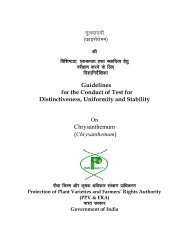
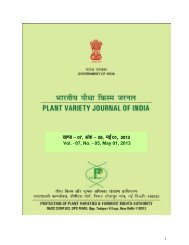
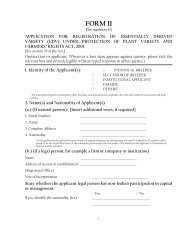
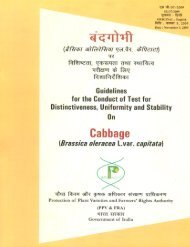

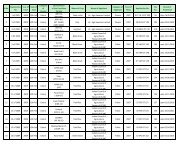
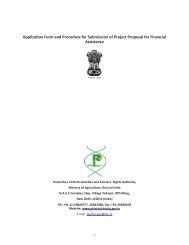
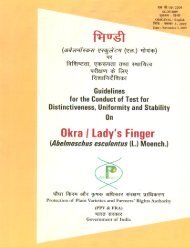
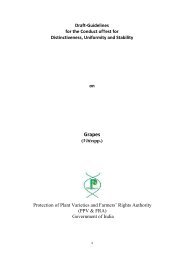
![vad & 12] fnlacj 01, 2010 - Protection of Plant Varieties & Farmers](https://img.yumpu.com/43179759/1/190x245/vad-12-fnlacj-01-2010-protection-of-plant-varieties-farmers.jpg?quality=85)
